16 44 In Simplest Form
Fraction in Lowest Terms
Fraction in everyman terms is discussed here.
If numerator and denominator of a fraction have no mutual factor other than ane(one), and then the fraction is said to be in its simple form or in lowest term.
In other words, a fraction is in its lowest terms or in lowest form, if the HCF of its numerator and denominator is one.
Consider the equivalent fractions:
\(\frac{ii}{3}\), \(\frac{4}{six}\), \(\frac{six}{nine}\), \(\frac{8}{12}\), \(\frac{10}{15}\) ........
That is , \(\frac{x ÷ five}{15 ÷ 5}\) = \(\frac{2}{3}\); \(\frac{10}{xv}\) = \(\frac{two}{three}\)
\(\frac{eight ÷ 4}{12 ÷ 4}\) = \(\frac{ii}{three}\); \(\frac{8}{12}\) = \(\frac{2}{3}\)
\(\frac{six ÷ three}{9 ÷ 3}\) = \(\frac{2}{three}\); \(\frac{6}{9}\) = \(\frac{2}{3}\)
\(\frac{2}{3}\) is the simplest class of the fraction \(\frac{10}{15}\) or \(\frac{8}{12}\) or \(\frac{6}{nine}\)
A fraction is in the lowest terms if the only common factor of the numerator and denominator is 1.
Notice the fractions represented past the colored portion in the following figures.
In effigy A colored role is represented by fraction \(\frac{viii}{sixteen}\).
The colored function in figure B is represented by fraction \(\frac{four}{8}\).
In figure C the colored function represents the fraction \(\frac{ii}{4}\) and
In figure D colored role represents \(\frac{1}{two}\).
When numerator and denominator of fraction \(\frac{8}{16}\) are divided by 2. Nosotros go \(\frac{4}{8}\) and in the aforementioned style \(\frac{4}{eight}\) gives \(\frac{ii}{4}\) and so \(\frac{1}{2}\).
Then, we discover that \(\frac{8}{16}\), \(\frac{4}{viii}\), \(\frac{two}{4}\) are equal to fraction for \(\frac{one}{2}\). Thus, \(\frac{1}{two}\) is the simplest or lowest class of all its equivalent fractions like \(\frac{two}{4}\), \(\frac{four}{8}\), \(\frac{8}{sixteen}\), \(\frac{16}{32}\), \(\frac{32}{64}\), …… etc.
Now, if we take all the factors of the numerator 8 and denominator 16 of the fraction \(\frac{8}{16}\), we get the post-obit:
All factors of 8 are 1, two, 4, 8.
All factors of sixteen are 1, 2, 4, 8, 16.
We detect that highest common factor (HCF) of 8 and 16 is 8.
On dividing both numerator and denominator by highest common factor nosotros get \(\frac{1}{ii}\).
Since, both numerator and denominator of fraction \(\frac{1}{two}\) have no common gene other than 1, we say that the fraction \(\frac{one}{2}\) is in its lowest terms or simplest form.
There are two methods to reduce a given fraction to its simplest form, viz., H.C.F. Method and Prime Factorization Method.
H.C.F. Method
Find the H.C.F. of the numerator and denominator of the given fraction.
In club to reduce a fraction to its lowest terms, we carve up its numerator and denominator by their HCF.
Example to reduce a fraction in everyman term, using H.C.F. Method:
1. Reduce the fraction ²¹/₅₆ to its simplest form.
Solution:
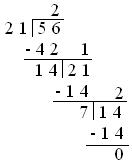
Therefore H.C.F. of 21 and 56 is 7.
We now divide the numerator and denominator of the given fraction past 7.
²¹/₅₆ = \(\frac{21 ÷ vii}{56 ÷ 7}\) = ³/₈.
2. Reduce ⁴⁸/₆₄ to its lowest form.
Solution:
First we notice the HCF of 48 and 64 past factorization method.
The factors of 48: 1, 2, 3, four, 6, 8, 12, 16, 24, and 48.
The factors of 64: ane, 2, 4, eight, 16, 32, and 64.
The mutual factors of 48 and 64 are: 1, 2, 4, 8, 12 and sixteen.
Therefore, HCF of 48 and 64 is 16.
Now ⁴⁸/₆₄ = \(\frac{48 ÷ xvi}{64 ÷ xvi}\)
[Dividing numerator and denominator by the HCF of 48 and 64 i.e., 16]
⇒ ⁴⁸/₆₄ = ³/₄
three. Reduce ⁴⁴/₇₂ to its everyman form.
Solution:
First we find the HCF of 44 and 72 past factorization method.
The factors of 44: 1, 2, 4, 11, 22 and 44.
The factors of 72: 1, two, three, 4, 6, eight, nine, 12, 18, 24, and 36.
The mutual factors of 44 and 72 are: 1, 2 and four.
Therefore, HCF of 44 and 72 is four.
Now ⁴⁴/₇₂ = \(\frac{44 ÷ 4}{72 ÷ iv}\)
[Dividing numerator and denominator by the HCF of 44 and 72 i.east., four]
⇒ 44/72 = 11/18
To modify a fraction to lowest terms:
4. Reduce \(\frac{10}{15}\) to its lowest terms:
Solution:
Step I:
Find the largest mutual factor of 10 and 15.
Factors of x: 1, 2, 5, 10
Factors of fifteen: one, 3, 5, 15
Mutual factors: ane, 5
H.C.F of 10 and 15 = 5
Stride Ii:
Separate both the numerator and denominator by the H.C.F.
\(\frac{10 ÷ 5}{xv ÷ 5}\) = \(\frac{2}{3}\)
Therefore, \(\frac{10}{15}\) = \(\frac{2}{3}\) (in its lowest terms)
ii. Reduce \(\frac{18}{45}\) to its everyman terms.
| Solution: H.C.F. of eighteen and 45 is 3 × 3 = 9 \(\frac{xviii ÷ nine}{45 ÷ 9}\) = \(\frac{two}{v}\) Therefore, \(\frac{18}{45}\) = \(\frac{ii}{5}\) (in its lowest terms) | |
Prime Factorization Method
Express both numerator and denominator of the given fraction every bit the product of prime number factors and so cancel the common factors from them.
Example to reduce a fraction in lowest term, using Prime Factorization Method:
Reduce \(\frac{120}{360}\) to the lowest term.
Solution:
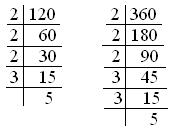
120 = 2 × 2 × two × iii × 5 = 1
360 2 × 2 × 2 × 3 × iii × 5 iii
Solve Examples on Reducing Fractions to Lowest Terms:
ane. Limited \(\frac{28}{140}\) in the simplest form.
Solution:
Let us find all the factors of both numerator and denominator.
Factors of 28 are 1, 2, 4, vii, 14, 28
Factors of 140 are 1, two, 4, five, 7, 10, 14, 20, 28, 35, 70, 140
The highest common factor is 28. Now dividing both numerator and denominator by 28, nosotros get \(\frac{i}{5}\). The numerator 1 and denominator v have no common factors other than ane. And so, \(\frac{1}{5}\) is the simplest course of \(\frac{28}{140}\).
2. Is \(\frac{48}{168}\) in its simplest course?
Solution:
Let us observe HCF of numerator and denominator and then split up both by the highest common cistron.
The highest common gene is 2 × 2 × 2 × three = 24
Permit us split up both numerator and denominator past 24. We get \(\frac{2}{7}\).
And then, the fraction \(\frac{48}{168}\) is not in its simplest grade.
Simplifying a Fraction:
3. Simplify \(\frac{42}{84}\)
Method I:
| Steps I:Divide numerator and denominator by 2. 42 ÷ two = 21; 84 ÷ 2 = 42; we go \(\frac{21}{42}\) Steps II:Carve up 21 and 42 past three. 21 ÷ 3 = 7; 42 ÷ 3 = xiv; we get \(\frac{7}{14}\) Steps III:Divide 7 and 14 by seven. vii ÷ 7 = i; 14 ÷ vii = 2; we get \(\frac{1}{2}\) Therefore, \(\frac{42}{84}\) = \(\frac{1}{two}\), in its everyman terms | |

Simplify \(\frac{42}{84}\)
Method II:
H.C.F of 42 and 84
= ii × 3 × 7
= 42
At present divide the numerator and denominator by the H.C.F. i.due east., 42
\(\frac{42 ÷ 42}{84 ÷ 42}\) = \(\frac{1}{2}\) in its lowest terms.
Questions and Answers on Reduce a Fraction to its Simplest Grade:
1. Convert the given fractions in lowest form:
(i) \(\frac{2}{4}\)
(ii) \(\frac{iii}{9}\)
(three) \(\frac{iv}{16}\)
(iv) \(\frac{12}{15}\)
(v) \(\frac{7}{28}\)
(vi) \(\frac{6}{10}\)
(vii) \(\frac{9}{72}\)
(viii) \(\frac{24}{36}\)
Answers:
ane. (i) \(\frac{1}{2}\)
(2) \(\frac{1}{iii}\)
(iii) \(\frac{one}{4}\)
(iv) \(\frac{4}{5}\)
(v) \(\frac{1}{4}\)
(vi) \(\frac{3}{5}\)
(seven) \(\frac{i}{8}\)
(viii) \(\frac{two}{3}\)
2. Reduce the post-obit fractions to their lowest terms.
(i) \(\frac{12}{sixty}\)
(2) \(\frac{13}{169}\)
(iii) \(\frac{seven}{35}\)
(iv) \(\frac{12}{28}\)
(v) \(\frac{3}{27}\)
(vi) \(\frac{80}{100}\)
(seven) \(\frac{14}{eighteen}\)
(8) \(\frac{29}{58}\)
(ix) \(\frac{ix}{63}\)
(x) \(\frac{90}{128}\)
Answer:
two.(i) \(\frac{1}{v}\)
(ii) \(\frac{1}{13}\)
(iii) \(\frac{1}{v}\)
(iv) \(\frac{3}{7}\)
(v) \(\frac{1}{9}\)
(vi) \(\frac{four}{v}\)
(seven) \(\frac{7}{nine}\)
(eight) \(\frac{1}{ii}\)
(ix) \(\frac{1}{vii}\)
(x) \(\frac{45}{64}\)
3. Write the fraction which is in the lowest terms in each set of equivalent fractions.
(i) [\(\frac{15}{65}\), \(\frac{three}{13}\), \(\frac{xxx}{130}\)]
(ii) [\(\frac{ane}{9}\), \(\frac{viii}{72}\), \(\frac{5}{45}\)]
(3) [\(\frac{50}{70}\), \(\frac{v}{7}\), \(\frac{25}{35}\)]
(four) [\(\frac{three}{11}\), \(\frac{33}{121}\), \(\frac{15}{55}\)]
Respond:
3.(i) \(\frac{3}{13}\)
(ii) \(\frac{1}{9}\)
(iii) \(\frac{5}{seven}\)
(4) \(\frac{three}{11}\)
iv. State truthful or false:
(i) \(\frac{five}{viii}\) = \(\frac{55}{eight}\)
(ii) \(\frac{vi}{48}\) = \(\frac{1}{viii}\)
(iii) \(\frac{6}{9}\) = \(\frac{48}{75}\)
(four) \(\frac{7}{eight}\) = \(\frac{9}{x}\)
(v) \(\frac{viii}{vi}\) = \(\frac{28}{21}\)
Answer:
4.(i) Simulated
(ii) True
(iii) False
(iv) False
(v) Imitation
v. Lucifer the given fractions:
| (i) \(\frac{12}{xv}\) (ii) \(\frac{6}{9}\) (iii) \(\frac{eight}{36}\) (four) \(\frac{24}{32}\) (v) \(\frac{fifteen}{25}\) | (a) \(\frac{3}{4}\) (b) \(\frac{2}{9}\) (c) \(\frac{three}{five}\) (d) \(\frac{iv}{five}\) (e) \(\frac{2}{3}\) |
Answers:
5.
| (i) \(\frac{12}{15}\) (ii) \(\frac{half dozen}{9}\) (iii) \(\frac{eight}{36}\) (iv) \(\frac{24}{32}\) (v) \(\frac{15}{25}\) | (d) \(\frac{four}{5}\) (e) \(\frac{2}{iii}\) (b) \(\frac{2}{9}\) (a) \(\frac{three}{iv}\) (c) \(\frac{3}{five}\) |
vi. Write the fraction for given statements and convert them to the lowest form.
| Statement | Fraction | Everyman Form |
| (i) Ten minutes to an hr | ||
| (ii) Amy ate 3 out of the 9 slices of a pizza | ||
| (iii) Eight months to a year | ||
| (iv) Kelly colored 4 out of 12 parts of a drawing | ||
| (v) Jack works for viii hours in a day. |
Answers:
6.
| Argument | Fraction | Lowest Grade |
| (i) X minutes to an hour | \(\frac{l}{lx}\) | \(\frac{5}{vi}\) |
| (ii) Amy ate iii out of the 9 slices of a pizza | \(\frac{3}{9}\) | \(\frac{1}{iii}\) |
| (iii) Eight months to a year | \(\frac{8}{12}\) | \(\frac{ii}{three}\) |
| (iv) Kelly colored 4 out of 12 parts of a cartoon | \(\frac{4}{12}\) | \(\frac{1}{3}\) |
| (v) Jack works for viii hours in a twenty-four hours. | \(\frac{8}{24}\) | \(\frac{ane}{3}\) |
vii. Give the fraction of the colored figure and catechumen in the lowest form.
| Figure | Fraction | Lowest Form | |
| (i) | | ||
| (ii) | | ||
| (iii) | | ||
| (four) | |
7.
Answers:
| Figure | Fraction | Lowest Form | |
| (i) | | \(\frac{2}{8}\) | \(\frac{1}{iv}\) |
| (two) | | \(\frac{iv}{viii}\) | \(\frac{1}{ii}\) |
| (iii) | | \(\frac{6}{12}\) | \(\frac{ane}{2}\) |
| (iv) | | \(\frac{two}{6}\) | \(\frac{i}{3}\) |
8. Simplify the following fractions:
(i) \(\frac{75}{fourscore}\)
(two) \(\frac{12}{20}\)
(iii) \(\frac{25}{45}\)
(iv) \(\frac{18}{24}\)
(v) \(\frac{125}{500}\)
Answer:
8. (i) \(\frac{15}{xvi}\)
(ii) \(\frac{3}{5}\)
(3) \(\frac{five}{9}\)
(4) \(\frac{3}{4}\)
(v) \(\frac{1}{iv}\)
● Fractions
Fractions
Types of Fractions
Equivalent Fractions
Like and Different Fractions
Conversion of Fractions
Fraction in Everyman Terms
Addition and Subtraction of Fractions
Multiplication of Fractions
Division of Fractions
● Fractions - Worksheets
Worksheet on Fractions
Worksheet on Multiplication of Fractions
Worksheet on Division of Fractions
7th Grade Math Problems
From Fraction in Everyman Terms to Dwelling house PAGE
Didn't discover what you were looking for? Or want to know more than data nigh Math Just Math. Utilize this Google Search to find what you demand.
16 44 In Simplest Form,
Source: https://www.math-only-math.com/fraction-in-lowest-terms.html
Posted by: whitemashe1946.blogspot.com

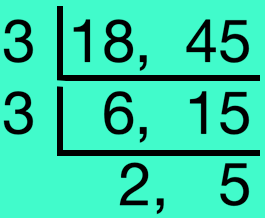
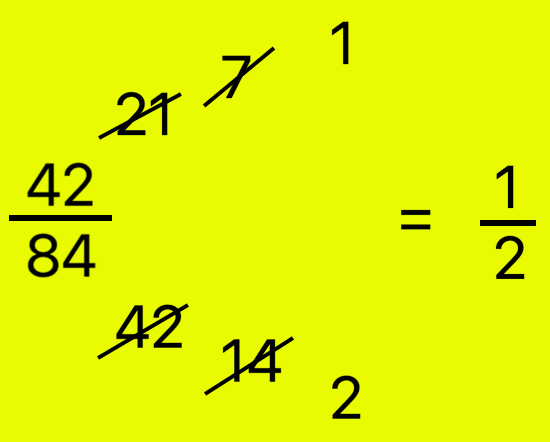
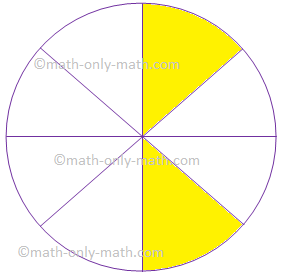
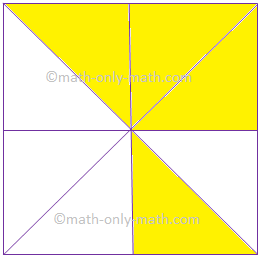
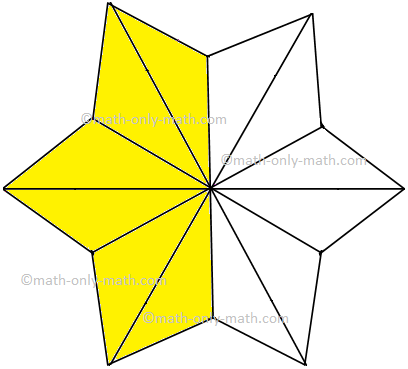
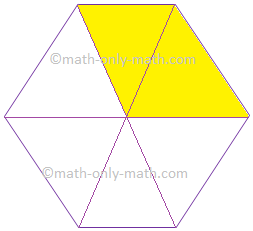

0 Response to "16 44 In Simplest Form"
Post a Comment